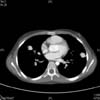Abstract
Hereditary hemorrhagic telangiectasia (HHT), also known as Rendu-Osler-Weber disease, is a rare autosomal dominant vascular disorder involving arteriovenous malformation (AVM) due to angiodysplasia. HHT is characterized by mucocutaneous hemorrhagic telangiectasia and AVM of various different organs. The mutated genes in HHT encode proteins that mediate signaling by the transforming growth factor-β superfamily, leading to migration and proliferation of endothelial cells to finally result in AVMs of various organs. Amongst various affected organs, pulmonary AVM is the most common. This 11-year-old female patient with a past and familial history of frequent epistaxis visited the hospital for abdominal pain and vomiting which developed on the same day. Nodular opacity was found in chest X-ray. Subsequently, AVMs in the lungs and the spleen were recognized in chest computed tomography along with detection of ENG gene mutation. Here we report a case of hereditary hemorrhagic telangiectasia diagnosed by incidental chest X-ray findings followed by genetic and radiologic studies.
Figures and Tables
 | Fig. 4DNA analysis of ENG. Y in Black box means base C and T. CAG is a genetic codon for Gln (56th amino acid of ENG) and TAG is nonsense codon. |
 | Fig. 5(A) A transverse section of the lung tissue in left lower lobe by wedge resection: relatively ill-defined hemorrhagic nodule, which consists of dilated tortuous blood vessels with thin walls, filled with entrapped dark brown blood clot. (B) Microscopic findings of the lung tissue: it shows parts of the wall of the dilated blood vessels with focal thickening due to fibroblast proliferation (H&E, ×100). |
References
1. McDonald J, Pyeritz RE. Pagon RA, Bird TD, Dolan CR, Stephens K, Adam MP, editors. Hereditary hemorrhagic telangiectasia. Genereviews [Internet]. 1993. cited 2012 Sep 30. Seattle: University of Washington;Available from http://www.ncbi.nlm.nih.gov/books/NBK1351/.

2. Dupuis-Girod S, Bailly S, Plauchu H. Hereditary hemorrhagic telangiectasia: from molecular biology to patient care. J Thromb Haemost. 2010. 8:1447–1456.

3. Al-Saleh S, Mei-Zahav M, Faughnan ME, MacLusky IB, Carpenter S, Letarte M, et al. Screening for pulmonary and cerebral arteriovenous malformations in children with hereditary haemorrhagic telangiectasia. Eur Respir J. 2009. 34:875–881.

4. Brady AP, Murphy MM, O'Connor TM. Hereditary haemorrhagic telangiectasia: a cause of preventable morbidity and mortality. Ir J Med Sci. 2009. 178:135–146.

5. Plauchu H, de Chadarevian JP, Bideau A, Robert JM. Age-related clinical profile of hereditary hemorrhagic telangiectasia in an epidemiologically recruited population. Am J Med Genet. 1989. 32:291–297.

6. Easey AJ, Wallace GM, Hughes JM, Jackson JE, Taylor WJ, Shovlin CL. Should asymptomatic patients with hereditary haemorrhagic telangiectasia (HHT) be screened for cerebral vascular malformations? Data from 22, 061 years of HHT patient life. J Neurol Neurosurg Psychiatry. 2003. 74:743–748.

7. Cottin V, Chinet T, Lavole A, Corre R, Marchand E, Reynaud-Gaubert M, et al. Pulmonary arteriovenous malformations in hereditary hemorrhagic telangiectasia: a series of 126 patients. Medicine (Baltimore). 2007. 86:1–17.

8. Shovlin CL. Hereditary haemorrhagic telangiectasia: pathophysiology, diagnosis and treatment. Blood Rev. 2010. 24:203–219.

9. Dheyauldeen S, Abdelnoor M, Bachmann-Harildstad G. The natural history of epistaxis in patients with hereditary hemorrhagic telangiectasia in the Norwegian population: a cross-sectional study. Am J Rhinol Allergy. 2011. 25:214–218.

10. de Gussem EM, Edwards CP, Westernann CJ, Faughnan ME, Mager JJ. Life expectancy of parents with hereditary hemoarrhagic telangiectasia. Hematol Meet Rep. 2009. 3:11–12.
11. Giordano P, Nigro A, Lenato GM, Guanti G, Suppressa P, Lastella P, et al. Screening for children from families with Rendu-Osler-Weber disease: from geneticist to clinician. J Thromb Haemost. 2006. 4:1237–1245.

12. Krings T, Chng SM, Ozanne A, Alvarez H, Rodesch G, Lasjaunias PL. Hereditary hemorrhagic telangiectasia in children: endovascular treatment of neurovascular malformations: results in 31 patients. Neuroradiology. 2005. 47:946–954.

13. Siddiki H, Doherty MG, Fletcher JG, Stanson AW, Vrtiska TJ, Hough DM, et al. Abdominal findings in hereditary hemorrhagic telangiectasia: pictorial essay on 2D and 3D findings with isotropic multiphase CT. Radiographics. 2008. 28:171–184.

14. Kwon HJ, Choi JC, Oh JY, Cho JH, Kang M, Lee JH, et al. Splenic arteriovenous malformation manifestated by thrombocytopenia in hereditary hemorrhagic telangiectasia: a case report. J Korean Radiol Soc. 2008. 59:197–200.

15. Sood N, Sood N, Dhawan V. Pulmonary arteriovenous malformation (AVM) causing tension hemothorax in a pregnant woman requiring emergent cesarean delivery. Pulm Med. 2011. 2011:865195.

16. Varnholt H, Kradin R. Pulmonary capillary hemangiomatosis arising in hereditary hemorrhagic telangiectasia. Hum Pathol. 2004. 35:266–268.

17. Grzela K, Krenke K, Kulus M, Krenke R. Pulmonary arteriovenous malformations: clinical and radiological presentation. J Pediatr. 2011. 158:856–856.e1.

18. Curie A, Lesca G, Cottin V, Edery P, Bellon G, Faughnan ME, et al. Long-term follow-up in 12 children with pulmonary arteriovenous malformations: confirmation of hereditary hemorrhagic telangiectasia in all cases. J Pediatr. 2007. 151:299–306.





 PDF
PDF ePub
ePub Citation
Citation Print
Print





 XML Download
XML Download